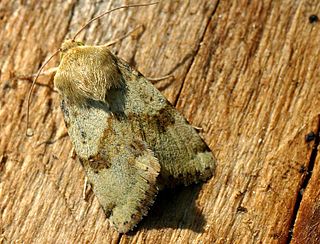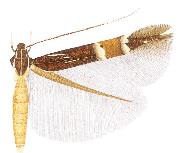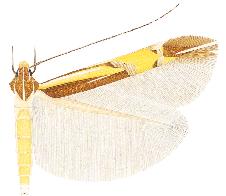
Appias lalage, the spot puffin, is a small butterfly of the family Pieridae, that is, the yellows and whites, which is found in India, Indochina and Hainan.

Appias libythea, the striped albatross, is a small butterfly of the family Pieridae, that is, the yellows and whites, which is found in south and southeast Asia.

Heliothis viriplaca, the marbled clover, is a moth of the family Noctuoidea. It is found in Europe and across the Palearctic to Central Asia then to Japan, Korea and Sakhalin. In the south, it penetrates to Kashmir and Myanmar. As a migratory moth, it also reaches areas in northern Fennoscandia in some years. North of the Alps, both indigenous and immigrant individuals occur in certain areas. The heat-loving species occurs mainly on dry grasslands, fallow land, heathlands and sunny slopes and slopes and the edges of sand and gravel pits.

Cosmopterix chaldene is a moth of the family Cosmopterigidae. It is known from the Federal District of Brazil.

Cosmopterix chisosensis is a moth of the family Cosmopterigidae. It is known from Argentina and the United States.

Cosmopterix floridanella is a moth of the family Cosmopterigidae. It is found in the United States, the Cayman Islands, Cuba, Jamaica and the US Virgin Islands.

Cosmopterix harpalyke is a moth of the family Cosmopterigidae. It is known from the Federal District of Brazil.

Cosmopterix madeleinae is a moth of the family Cosmopterigidae. It is known from the Galapagos Islands.

Cosmopterix pulchrimella, the beautiful cosmopterix moth, is a moth of the family Cosmopterigidae. It is known from the United States and Canada. It is also present in the Palearctic realm, where it is known from the Mediterranean Basin, from Portugal to the western Transcaucasus, north to Switzerland and Hungary. It has also been recorded from the Azores, the Canary Islands and Madeira. It has recently been found in southern England.

Cosmopterix quadrilineella is a moth of the family Cosmopterigidae. It is known from the United States.

Cosmopterix yvani is a moth of the family Cosmopterigidae. It is known from the Galapagos Islands.
Onebala probolaspis is a moth in the family Gelechiidae. It was described by Edward Meyrick in 1929. It is found in South Africa.
Aristotelia chlorographa is a moth of the family Gelechiidae. It was described by Edward Meyrick in 1914. It is found in Mozambique and South Africa, where it has been recorded from Gauteng.
Coptotelia nigriplaga is a moth in the family Depressariidae. It was described by Paul Dognin in 1904. It is found in Colombia and Ecuador.
Gonionota incalescens is a moth in the family Depressariidae. It was described by Edward Meyrick in 1914. It is found in Colombia.
Hypercallia loxochorda is a moth in the family Depressariidae. It was described by Edward Meyrick in 1926. It is found in Colombia.
Hypercallia halobapta is a moth in the family Depressariidae. It was described by Edward Meyrick in 1930. It is found in Brazil.
Hypercallia chaldaica is a moth in the family Depressariidae. It was described by Edward Meyrick in 1913. It is found in Argentina.
Hypercallia cyathopa is a moth in the family Depressariidae. It was described by Edward Meyrick in 1913. It is found in Colombia.
Hypercallia psittacopa is a moth in the family Depressariidae. It was described by Edward Meyrick in 1912. It is found in Colombia.



